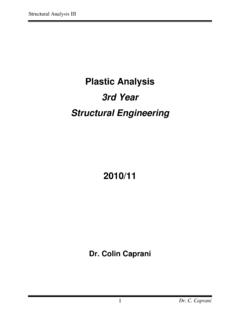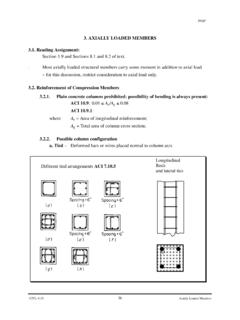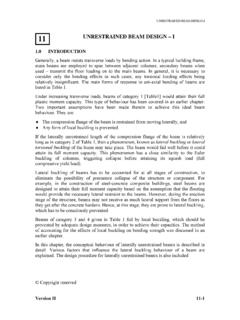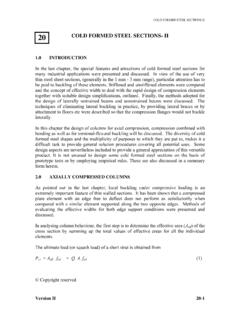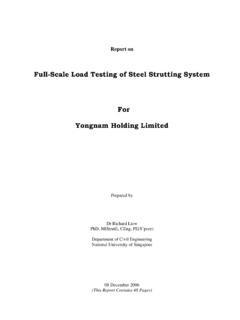Transcription of Design of Reinforced Concrete Columns - Colin …
1 Civil Engineering Design (1) Dr. C. Caprani 1 Civil Engineering Design (1) Design of Reinforced Concrete Columns 2006/7 Dr. Colin Caprani, Chartered Engineer Civil Engineering Design (1) Dr. C. Caprani 2 Contents 1. Introduction .. 3 3 Failure Modes .. 5 Design Aspects .. 7 Background 8 2. Short Braced axially loaded 10 10 Example .. 11 When loaded by Beams .. 12 3. Short Braced Columns Resisting Axial Load and Moment .. 13 13 Case 1: h .. 14 Case 2: > h .. 15 Combination of 16 Description of Interaction 18 Example .. 21 Design Using Standard Interaction Diagrams .. 30 4. Biaxial 33 33 Method 1 Resolution of Moments .. 34 Method 2 3-D Interaction 37 Method 3 Code Methods .. 39 Example.
2 41 Civil Engineering Design (1) Dr. C. Caprani 31. Introduction Background The two main parameters governing column Design are: Bracing: if the column can sway additional moments are generated through the P effect. This does not affect braced Columns Slenderness ratio: The effective length divided by the lateral dimension of the column. Low values indicate a crushing failure, while high values denote buckling. Bracing The two kinds of bracing are: Braced: Lateral loads on the structure are resisted by elements other than the Columns in the structure; lift cores, shear walls. Hence these Columns mainly take axial load; however, bending moments may result in the Columns due to unsymmetrical arrangements of loads.
3 Unbraced: Lateral loads are resisted by the bending action of the Columns . The axial loads are also taken by the Columns . Slenderness ratio The slenderness ratio is the ratio of the effective length el to the lateral dimension of the column in that direction. We have two directions on plan, and we can have two ratios: Long side of column: slenderness ratioexlh=; Short side of column: slenderness ratioeylb=. Civil Engineering Design (1) Dr. C. Caprani 4 Standard Column The effective length is calculated from a table in BS8110 and depends on the end-conditions of the column, for each axis: h b XXYYC ivil Engineering Design (1) Dr. C. Caprani Failure Modes We define: uzN as the crushing load of a perfectly axially loaded column; critN as Euler s buckling load for the column.
4 The following graph is typical and shows how for different slenderness ratios, different forms of failure are possible: Civil Engineering Design (1) Dr. C. Caprani 6 From the figure: For 15lh the crushing capacity is much lower than the buckling capacity and so the column crushes. For 32lh> the buckling capacity is less than the crushing capacity and so the column buckles. For lh values in between, the failure mode is not clear and depends on imperfections in the column and the way the load is applied. Therefore, BS8110 defines: Short Columns : 15lh for a braced column and 10lh for an unbraced column. These ratios must be met for both axes. Slender Columns : any column not meeting the criteria for short Columns .
5 As this module is short, we will only consider short, braced Columns . Civil Engineering Design (1) Dr. C. Caprani Design Aspects At SLS, the axial compression tends to close up the cracks, which is beneficial. Hence crack widths do not normally need to be checked in Columns (crack widths are checked in beams and slabs in water retaining structures and bridges, but don't need to be for Columns ). Further, deflections do not normally need to be checked in Columns . It is ULS conditions that govern the Design of Columns , , their strength. Areas of reinforcement are given for reference: Cross Sectional areas of groups of bars (mm2)Bar Size (mm)681012162025324012850791132013144918 0412572571011572264026289821608251338515 1236339603942147324133770411320131445280 4125719633217502751412513935651005157124 5440216283617030247167912061885294548257 5407198352550792140721993436563087968226 4026289051608251339276434 10053925445270710181810282744187238 113101028350378511312011314249098042 of bars Civil Engineering Design (1) Dr.
6 C. Caprani Background Information We can carry out a section analysis for Columns just as we do for beams. Review section analysis for beams as precursor to that for Columns . We need to use the material properties from BS8110. As a reminder, we have: Stress-Strain Curve for Steel from BS8110 Civil Engineering Design (1) Dr. C. Caprani 9 Stress-Strain Curve for Concrete from BS8110 Remember that the is to relate cube strength to bending strength and is not a factor of safety (which is m ). Civil Engineering Design (1) Dr. C. Caprani 102. Short Braced axially loaded Columns Development The Design of such Columns is straightforward. The ultimate force is the sum of the stress areas of the steel and Concrete : =+ For Concrete = and for steel = (this is due to change back shortly to ).
7 Therefore we have: + Because this relies on a perfect axial load which is virtually impossibly to achieve in practice, a small allowance for an eccentricity of is made to give: + For a rectangular section this is equal to: () + Notice that we have effectively reduced the stress in the steel to account for the Concrete that isn t present, but which we have allowed for in the first term. We will do this again. Civil Engineering Design (1) Dr. C. Caprani Example Problem A short braced column is 300 mm square and supports 1700 kN at the ultimate limit state. The characteristic material strengths are 2400 N/mmyf= and 230 N/mmcuf=, Design the steel for the column.
8 Solution Civil Engineering Design (1) Dr. C. Caprani When loaded by Beams Short braced Columns that support an approximately (within 15%) symmetrical arrangement of beams can be Design using: + For a rectangular section this is equal to: () + Redesign the previous problem for the case when it is loaded by such beams: Civil Engineering Design (1) Dr. C. Caprani 133. Short Braced Columns Resisting Axial Load and Moment Introduction This problem is not so straightforward. We must account for the various possible positions of the neutral axis, as the bending might be large compared to the axial load. Or indeed, vice-verse, in which case we should get our result for short braced axially -only loaded Columns .
9 Here, we consider the general case for rectangular Concrete Columns subject to moment M and axial load N. Remember: the basis is that the strain diagram is linear, and the ultimate strain of Concrete is =. Civil Engineering Design (1) Dr. C. Caprani Case 1: h In this case the equivalent rectangular stress block is inside the section and so part of the section is in compression, and part in tension. This occurs when a relatively small axial force and a large moment are applied. Taking 0xF= , we see: ccscstNF F F=+ For moment equilibrium,: about centre line 0M= '2222ccscsthshhMFFd Fd = + + cu sc s x Strain Diagram Stress/Force Diagram s = Asc As FscFcc FstNM Applied Loads d h d Beam Section b Civil Engineering Design (1) Dr.
10 C. Caprani Case 2: > h In this case the equivalent rectangular stress block is outside the section and so all of the section is in compression. This occurs when a relatively large axial force and a small moment are applied. Taking 0xF= : ccscstNF F F=+ Moment equilibrium: '22scsthhMFd Fd = cu sc sx Strain Diagram Stress/Force Diagram s = Asc As FscFcc FstNM Applied Loads d h d Beam Section b Civil Engineering Design (1) Dr. C. Caprani Combination of Cases Noting that the direction of stFchanges, and taking its positive direction to be that of compression, we combine the two cases: ccscstNF F F=+ '2222ccscsthshhMFFd Fd = + + Thus when stF is in tension and is negative, we get Case 1.




